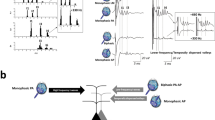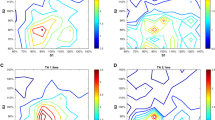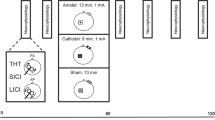Abstract
Paired-pulse magnetic stimulation has been widely used to study intracortical inhibition of the motor cortex. Inhibition at interstimulus intervals (ISIs) of 1–5 ms is ascribed to a GABAergic inhibitory system in the motor cortex. However, Fisher et al. have proposed that different mechanisms are operating at an ISI of 1 ms and 2.5 ms. In order to confirm their concept and clarify whether inhibition at all these intervals is produced by a single mechanism, we compared effects of paired-pulse stimulation at ISIs of 1 ms, 2 ms, and 3–5 ms. We evaluated how intracortical inhibition affected the I3-wave, I1-wave, magnetic D-wave, and anodal D-wave components of electromyographic (EMG) responses using previously reported methods. The data suggest that three separate effects occur within these ISIs. At ISIs of 3–5 ms, inhibition was evoked only in responses to I3-waves, whereas no inhibition was elicited in responses to I1-waves or magnetic D-waves. In contrast, at an ISI of 1 ms, responses to I3-waves and I1-waves were moderately suppressed. Moreover, even magnetic D-waves were slightly suppressed, whereas anodal D-waves were unaffected. At an ISI of 2 ms, none of the descending volleys were inhibited. We propose that we should use ISIs of 3–5 ms for estimating function of the GABAergic inhibitory system of the motor cortex by paired-pulse transcranial magnetic stimulation (TMS). Our results support the idea of Fisher et al. that the mechanism responsible for the inhibition at an ISI of 1 ms is not the same as that responsible for suppression at ISIs of 3–5 ms (GABAergic inhibitory circuits in the motor cortex). At an ISI of 2 ms, we suggest that the inhibitory influence evoked by the first stimulus (S1) should collide with or be occluded by the second stimulus (S2), which leads to the lack of inhibition when the subjects make a voluntary contraction of the target muscle.



Similar content being viewed by others
References
Alger BE, Nicoll R (1982) Feed-forward dendritic inhibition in rat hippocampal pyramidal cells studied in vitro. J Physiol (Lond) 328:105–123
Ashby P, Reynolds C, Wennberg R, Lozano AM, Rothwell J (1999) On the focal nature of inhibition and facilitation in the human motor cortex. Clin Neurophysiol 110:550–555
Bekenstein J, Rempe D, Lothman E (1993) Decreased heterosynaptic and homosynaptic paired-pulse inhibition in the rat hippocampus as a chronic sequel to limbic status epilepticus. Brain Res 601:111–120
Bindman LJ, Lippold OCJ, Milne AR (1979) Prolonged changes in excitability of pyramidal tract neurons in the cat: a post-synaptic mechanism. J Physiol (Lond) 286:457–477
Chen W, Zhang JJ, Hu GY, Wu CP (1995) GABAA receptor-mediated feedback inhibition in pyramidal neurons of cat motor cortex. Neurosci Lett 198:123–126
Chen R, Tam A, Bütefisch C, Corwell B, Ziemann U, Rothwell JC, Cohen LG (1998) Intracortical inhibition and facilitation in different representation of the human motor cortex. J Neurophysiol 80:2870–2881
Civardi C, Cavalli A, Naldi P, Varrasi C, Cantello R (2000) Hemispheric asymmetries of cortico-cortical connections in human hand motor areas. Clin Neurophysiol 111:624–629
Di Lazzaro V, Restuccia D, Oliviero A, Profice P, Ferrara L, Insola A, Mazzone P, Tonali P, Rothwell JC (1998) Magnetic transcranial stimulation at intensities below active motor threshold activates intracortical inhibitory circuits. Exp Brain Res 119:265–268
Di Lazzaro V, Rothwell JC, Oliviero A, Profice P, Insola A, Mazzone P, Tonali P (1999) Intracortical origin of the short-latency facilitation produced by pairs of threshold magnetic stimuli applied to human motor cortex. Exp Brain Res 129:494–499
Dingledine R, Korn SJ (1985) γ-aminobutyric acid uptake and the termination of inhibitory synaptic potentials in the rat hippocampal slice. J Physiol (Lond) 366:387–409
Fisher RJ, Nakamura Y, Bestmann S, Rothwell JC, Bostock H (2002) Two phases of intracortical inhibition revealed by transcranial magnetic threshold tracking. Exp Brain Res 143:240–248
Gorman ALF (1966) Differential patterns of activation of the pyramidal system elicited by surface anodal and cathodal cortical stimulation. J Neurophysiol 29:547–564
Hanajima R, Ugawa Y, Terao Y, Ogata K, Kanazawa I (1996) Ipsilateral cortico-cortical inhibition of the motor cortex in various neurological disorders. J Neurol Sci 140:109–116
Hanajima R, Ugawa Y, Terao Y, Sakai K, Furubayashi T, Machii K, Kanazawa I (1998) Paired-pulse magnetic stimulation of the human motor cortex: differences among I waves. J Physiol (Lond) 509:607–618
Inghilleri M, Berardelli A, Cruccu G, Priori A, Manfredi M (1989) Corticospinal potentials after transcranial stimulation in humans. J Neurol Neurosurg Psychiatry 52:970–974
Katayama Y, Tsubokawa T, Maejima S, Hirayama T, Yamamoto T (1988) Corticospinal direct response in humans: identification of the motor cortex during intracranial surgery under general anesthesia. J Neurol Neurosurg Psychiatry 51:50–59
Krnjevic K, Randic M, Straughan DW (1964) Cortical inhibition. Nature 201:1294–1296
Krnjevic K, Randic M, Straughan DW (1965) Pharmacology of cortical inhibition. J Physiol (Lond) 184:78–105
Kujirai T, Caramia MD, Rothwell JC, Day BL, Thompson PD, Ferbert A, Wroe S, Asselman P, Marsden CD (1993) Cortico-cortical inhibition in human motor cortex. J Physiol (Lond) 471:501–519
Matsumura M, Sawaguchi T, Kubota K (1992) GABAergic inhibition of neuronal activity in the primate motor and premotor cortex during voluntary movement. J Neurophysiol 68:692–702
Muellbacher W, Facchini S, Boroojerdi B, Hallet M (2000) Changes in motor cortex excitability during ipsilateral hand muscle activation in humans. Clin Neurophysiol 111(2): 344–349
Nakamura H, Kitagawa H, Kawaguchi Y, Tsuji H (1997) Intracortical facilitation and inhibition after transcranial magnetic stimulation in conscious humans. J Physiol (Lond) 498:817–823
Patton H, Amassian VE (1954) Single- and multiple-unit analysis of cortical stage of pyramidal tract activation. J Neurophysiol 17:345–363
Ridding MC, Inzelberg R, Rothwell JC (1995a) Changes in excitability of motor cortical circuitry in patients with Parkinson's disease. Ann Neurol 37:181–188
Ridding MC, Sheean G, Rothwell JC, Inzelberg R, Kujirai T (1995b) Changes in the balance between motor cortical excitation and inhibition in focal, task specific dystonia. J Neurol Neurosurg Psychiatry 59:493–498
Ridding MC, Taylor JL, Rothwell JC (1995c) The effect of voluntary contraction on cortico-cortical inhibition in human motor cortex. J Physiol (Lond) 487:541–548
Sakai K, Ugawa Y, Terao Y, Hanajima R, Furubayashi T, Kanazawa I (1997) Preferential activation of different I waves by transcranial magnetic stimulation with a figure-eight shaped coil. Exp Brain Res 113:24–32
Werhahn KJ, Fong JKY, Meyer BU, Priori A, Rothwell JC, Day BL, Thompson PD (1994) The effect of magnetic coil orientation on the latency of surface EMG and single motor unit responses in the first dorsal interosseous muscle. Electroencephalogr Clin Neurophysiol 93:138–146
Ziemann U, Bruns D, Paulus W (1996a) Enhancement of human motor cortex inhibition by the dopamine receptor agonist pergolide: evidence from transcranial magnetic stimulation. Neurosci Lett 208:187–190
Ziemann U, Lönnecker S, Steinhoff BJ, Paulus W (1996b) The effect of lorazepam on the motor cortical excitability in man. Exp Brain Res 109:127–135
Ziemann U, Lönnecker S, Steinhoff BJ, Paulus W (1996c) Effects of antiepileptic drugs on motor cortex excitability in humans: a transcranial magnetic stimulation study. Ann Neurol 40:367–378
Ziemann U, Winter M, Reimers CD, Reimers K, Tergau F, Paulus W (1997) Impaired motor cortex inhibition in patients with amyotrophic lateral sclerosis. Evidence from paired transcranial magnetic stimulation. Neurology 49:1292–1298
Acknowledgements
Part of this work was supported by Research Project Grant-in-aid for Scientific Research No. 12680768 from the Ministry of Education, Science, Sports and Culture of Japan.
Author information
Authors and Affiliations
Corresponding author
Rights and permissions
About this article
Cite this article
Hanajima, R., Furubayashi, T., Iwata, N.K. et al. Further evidence to support different mechanisms underlying intracortical inhibition of the motor cortex. Exp Brain Res 151, 427–434 (2003). https://doi.org/10.1007/s00221-003-1455-z
Received:
Accepted:
Published:
Issue Date:
DOI: https://doi.org/10.1007/s00221-003-1455-z




